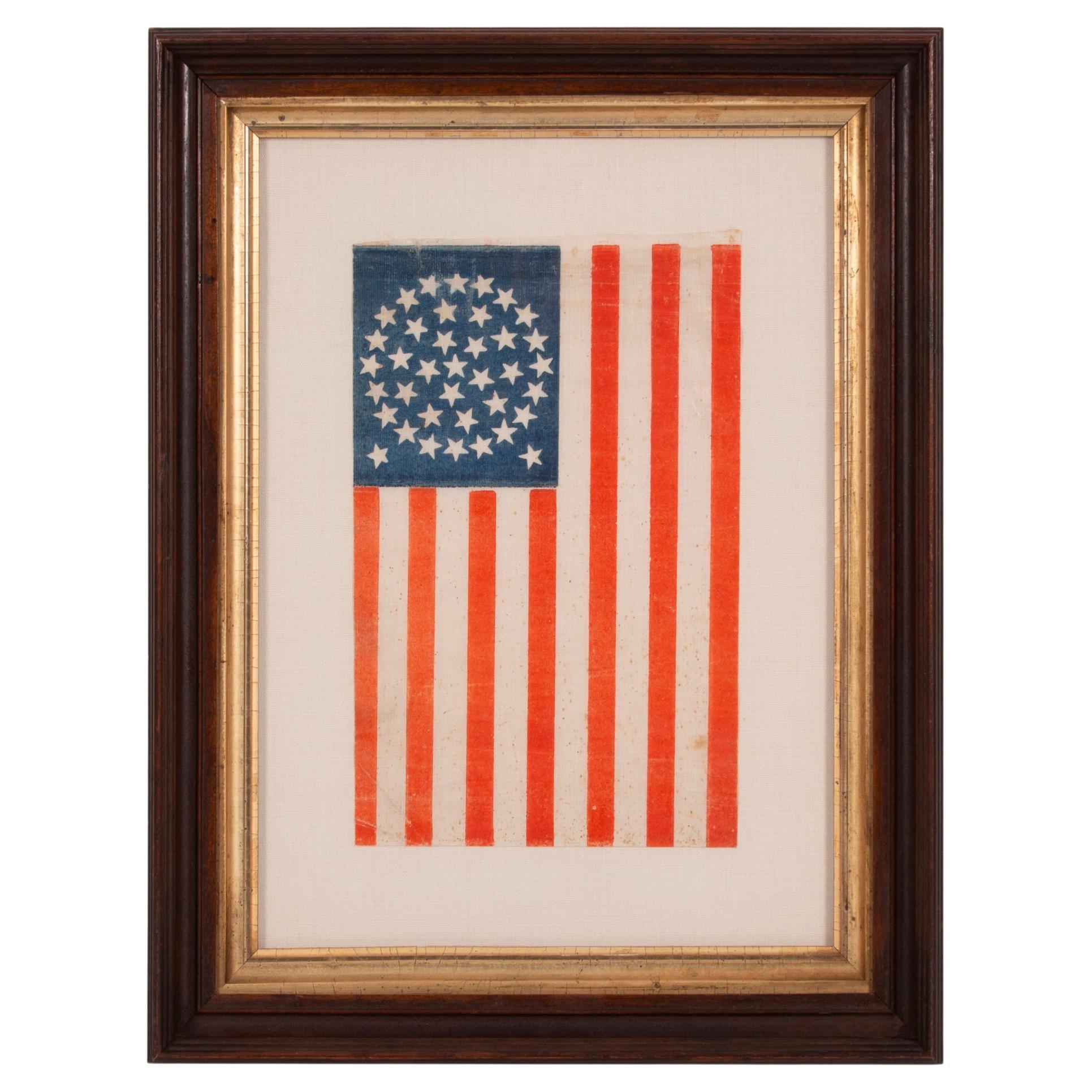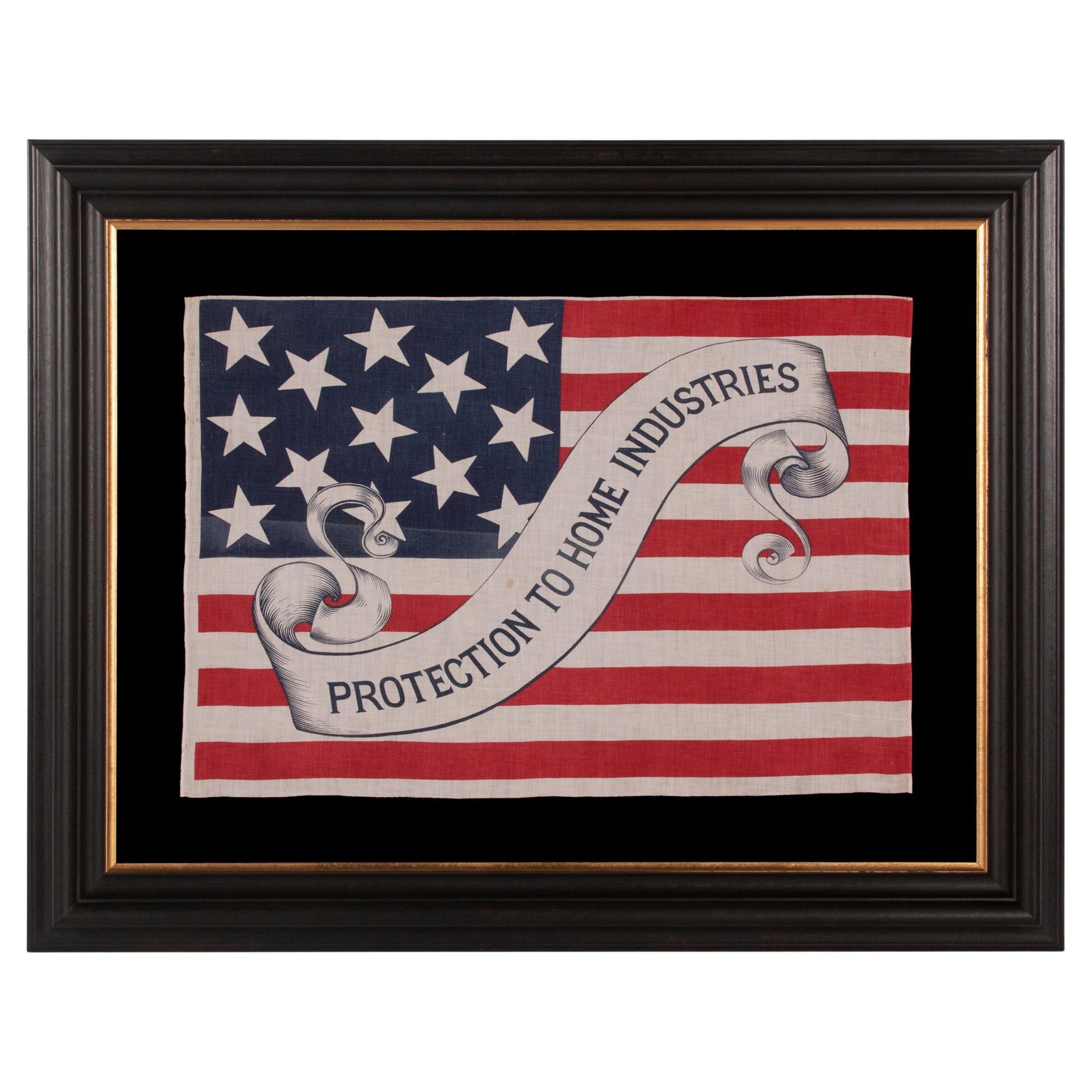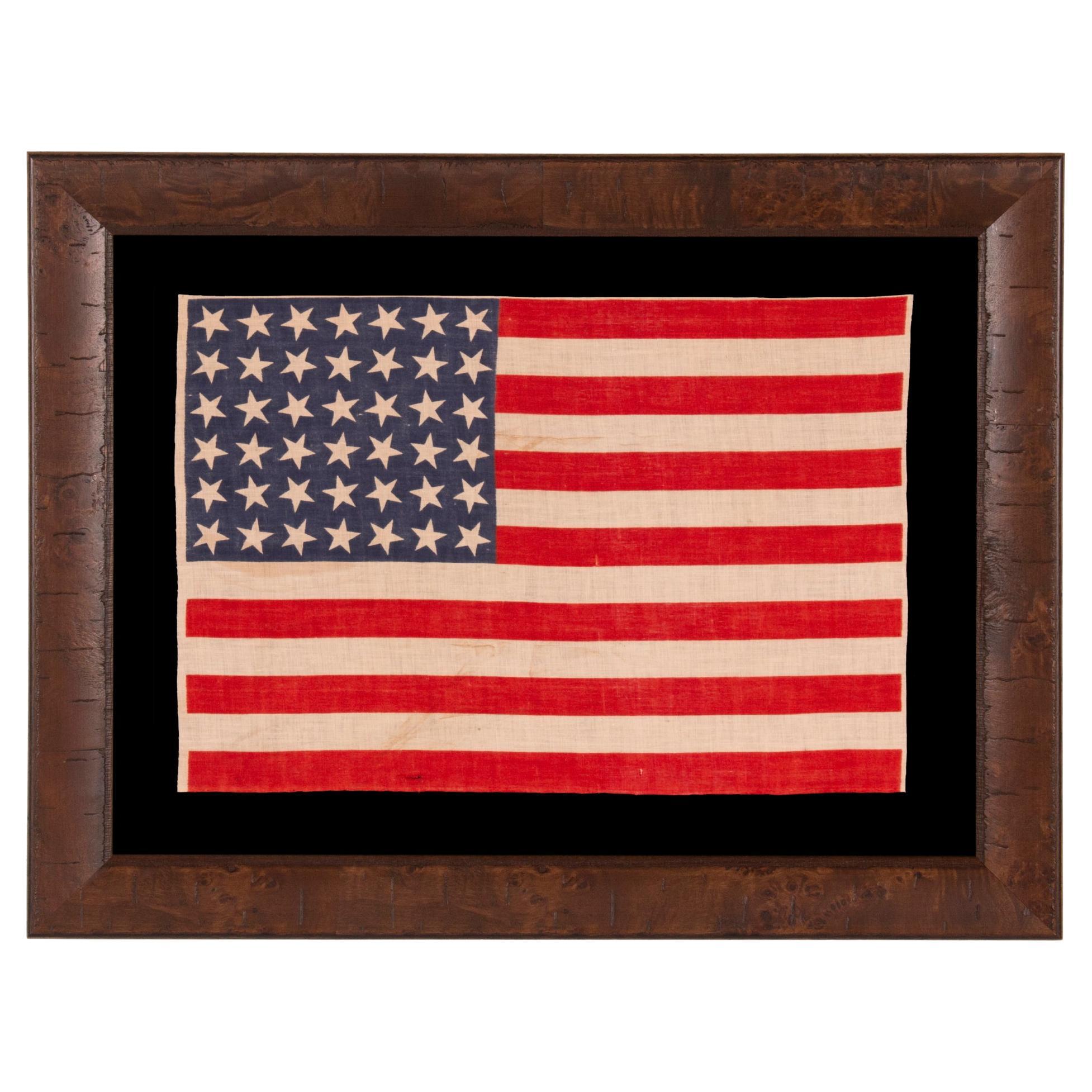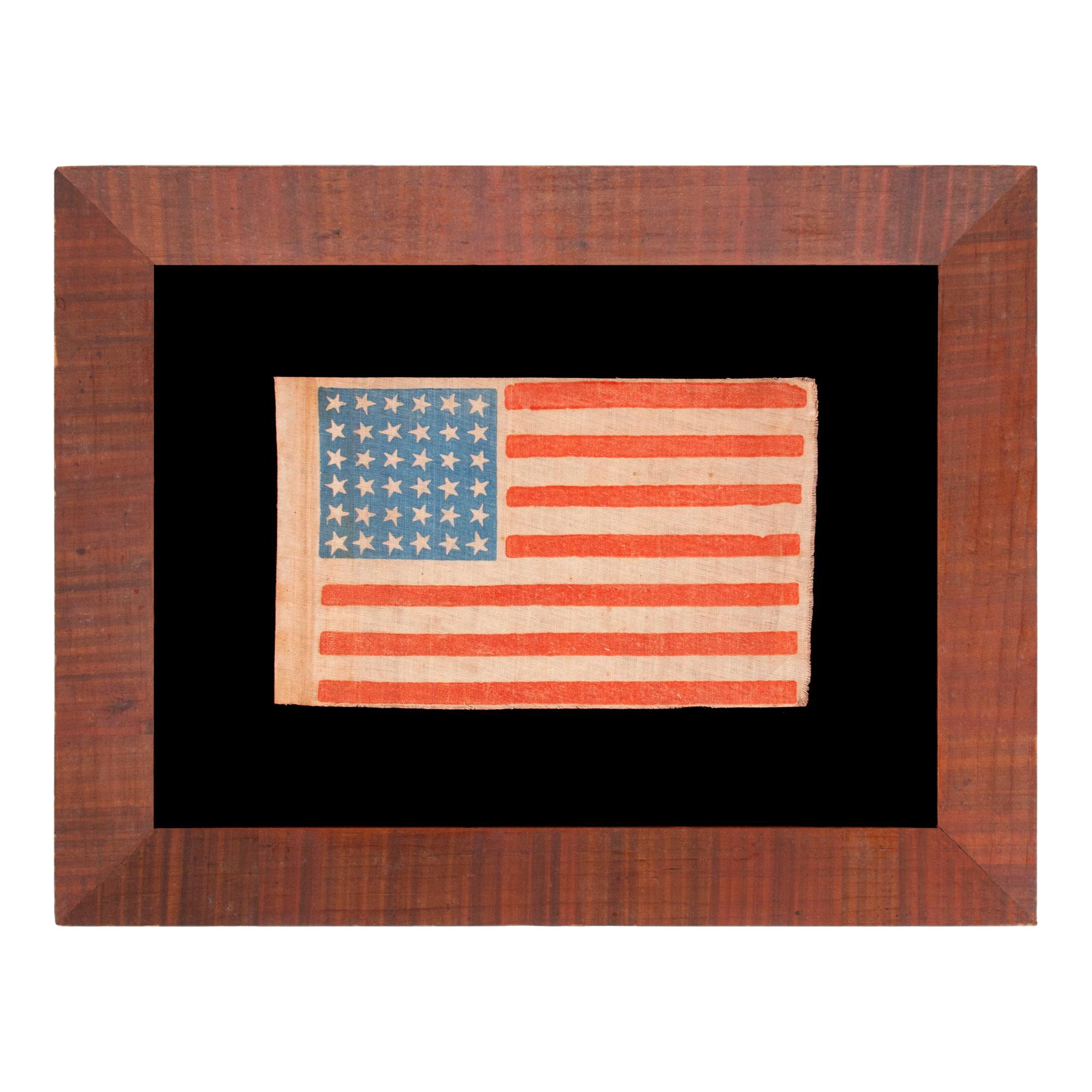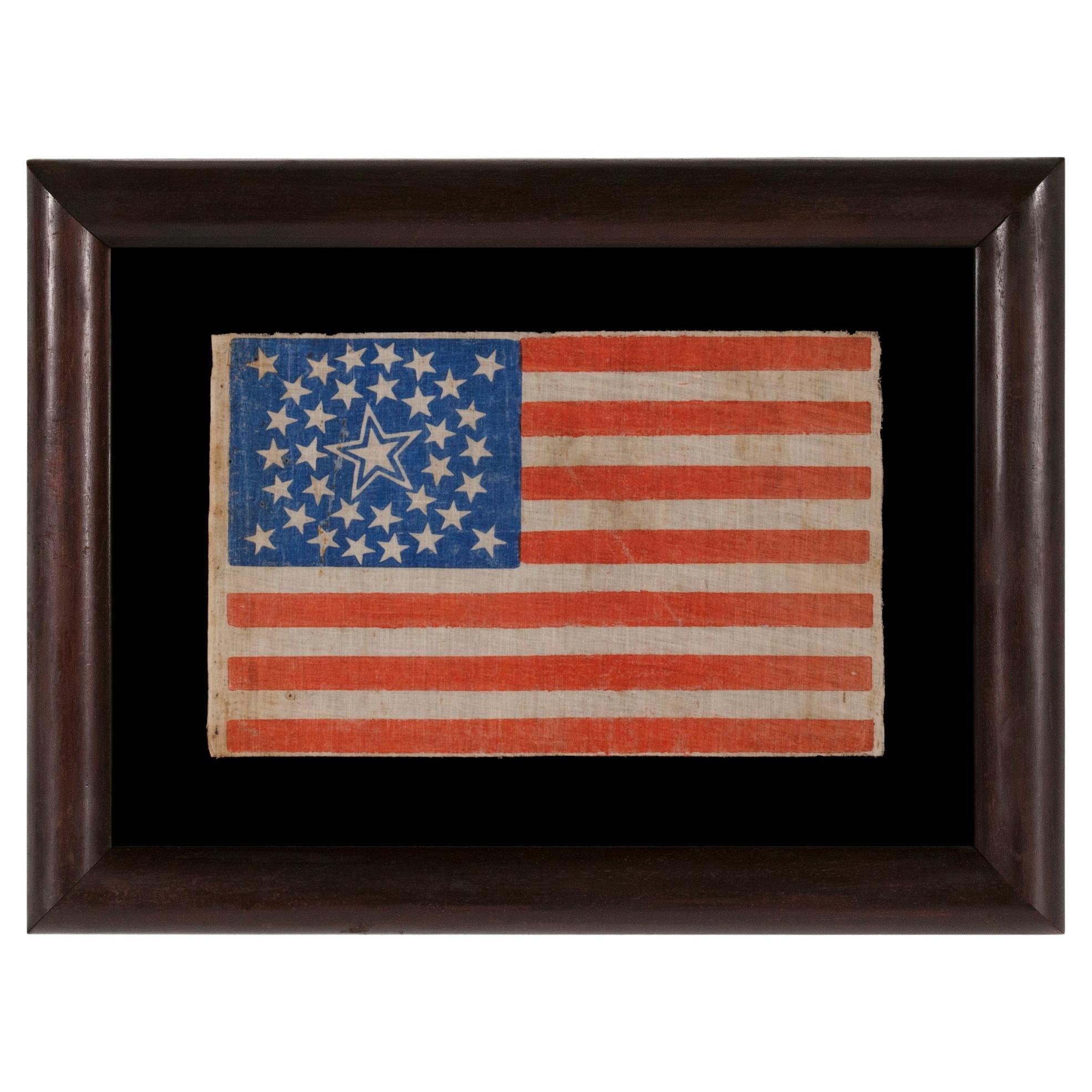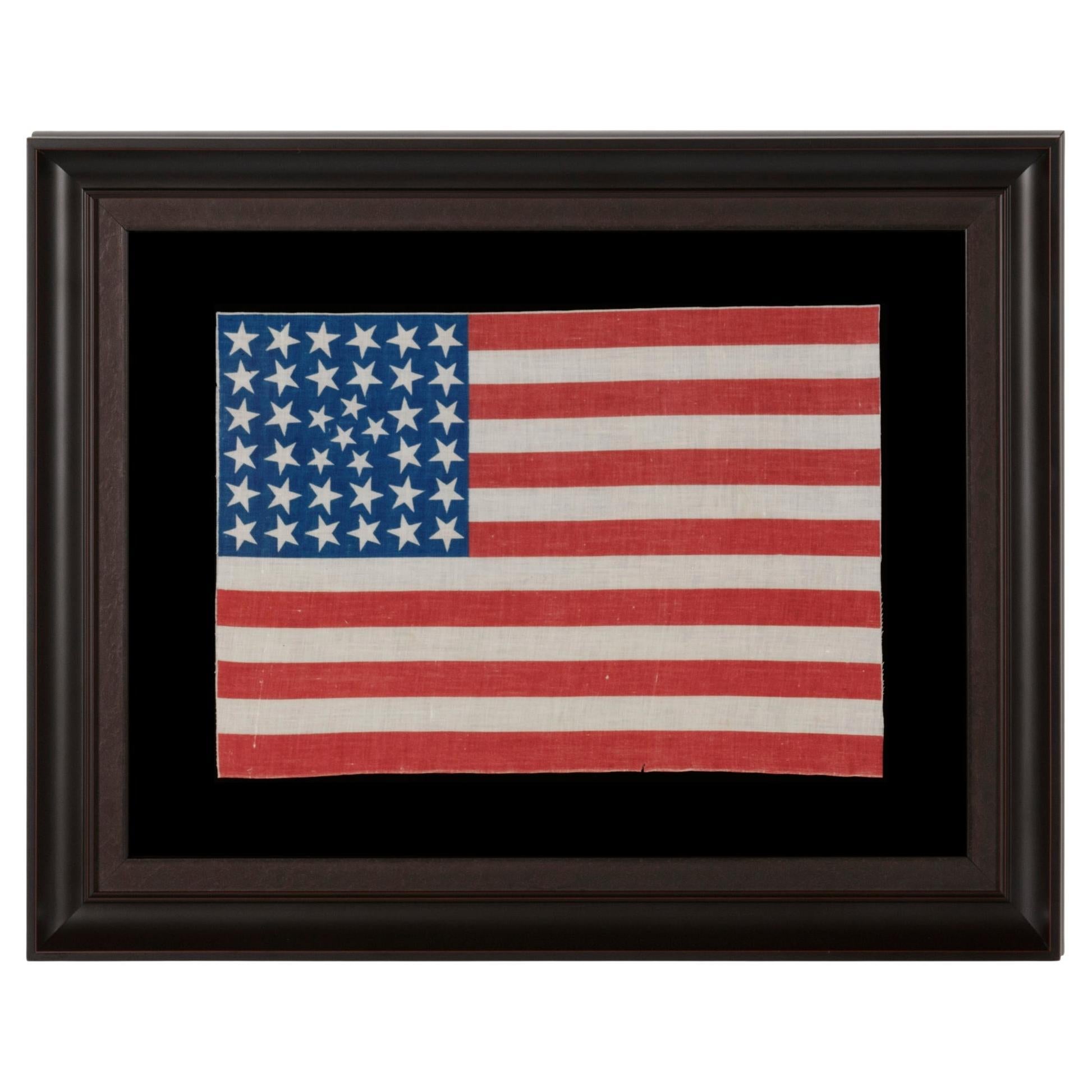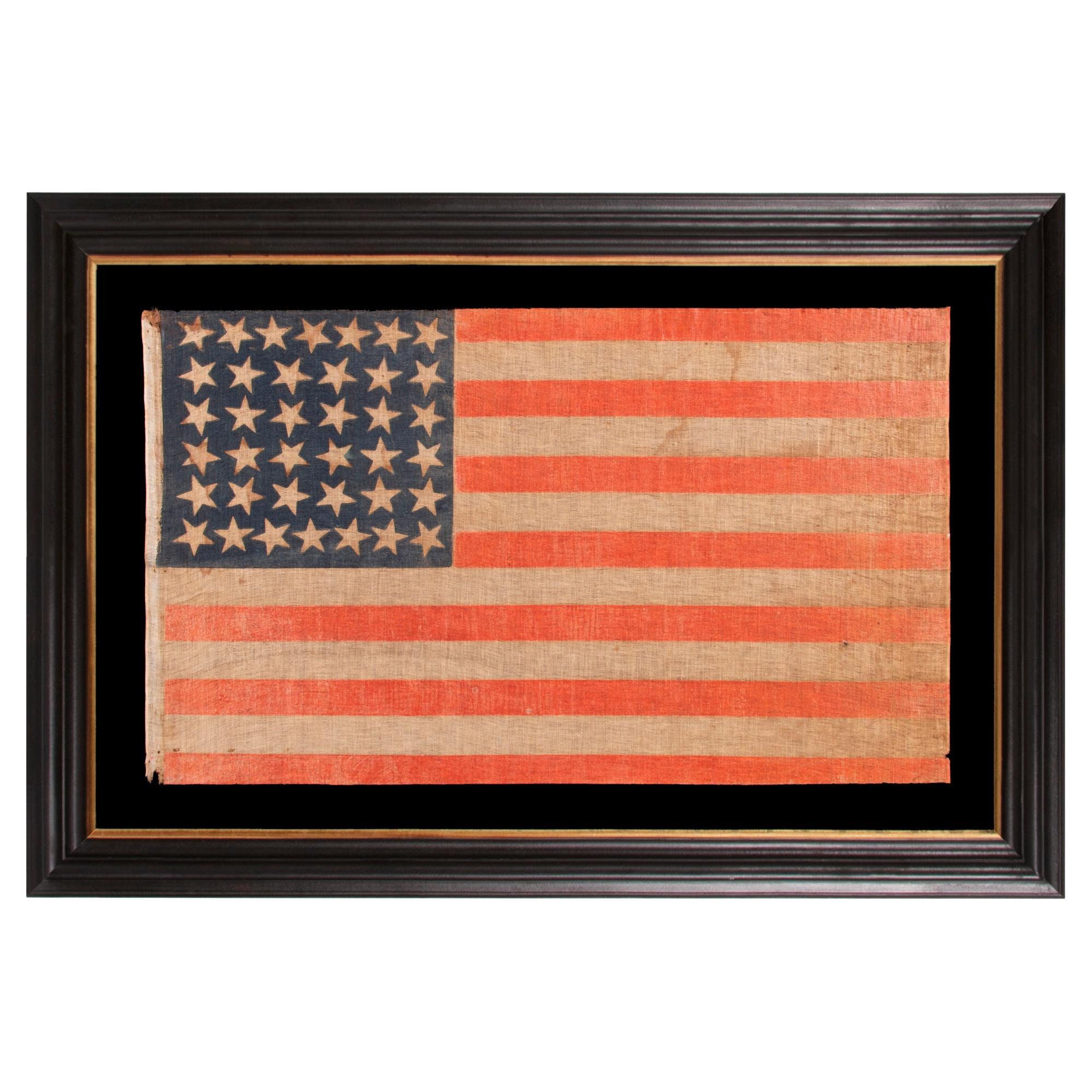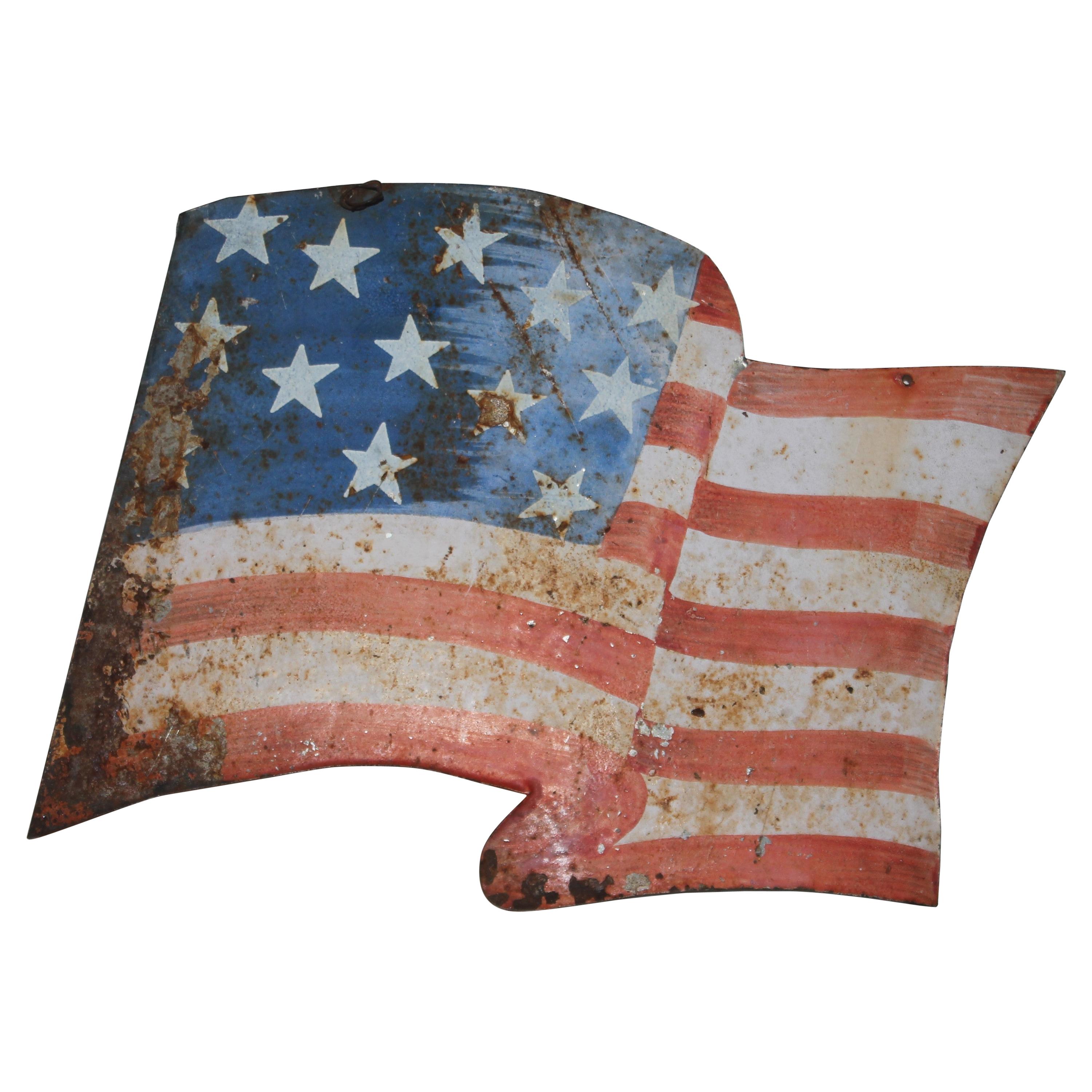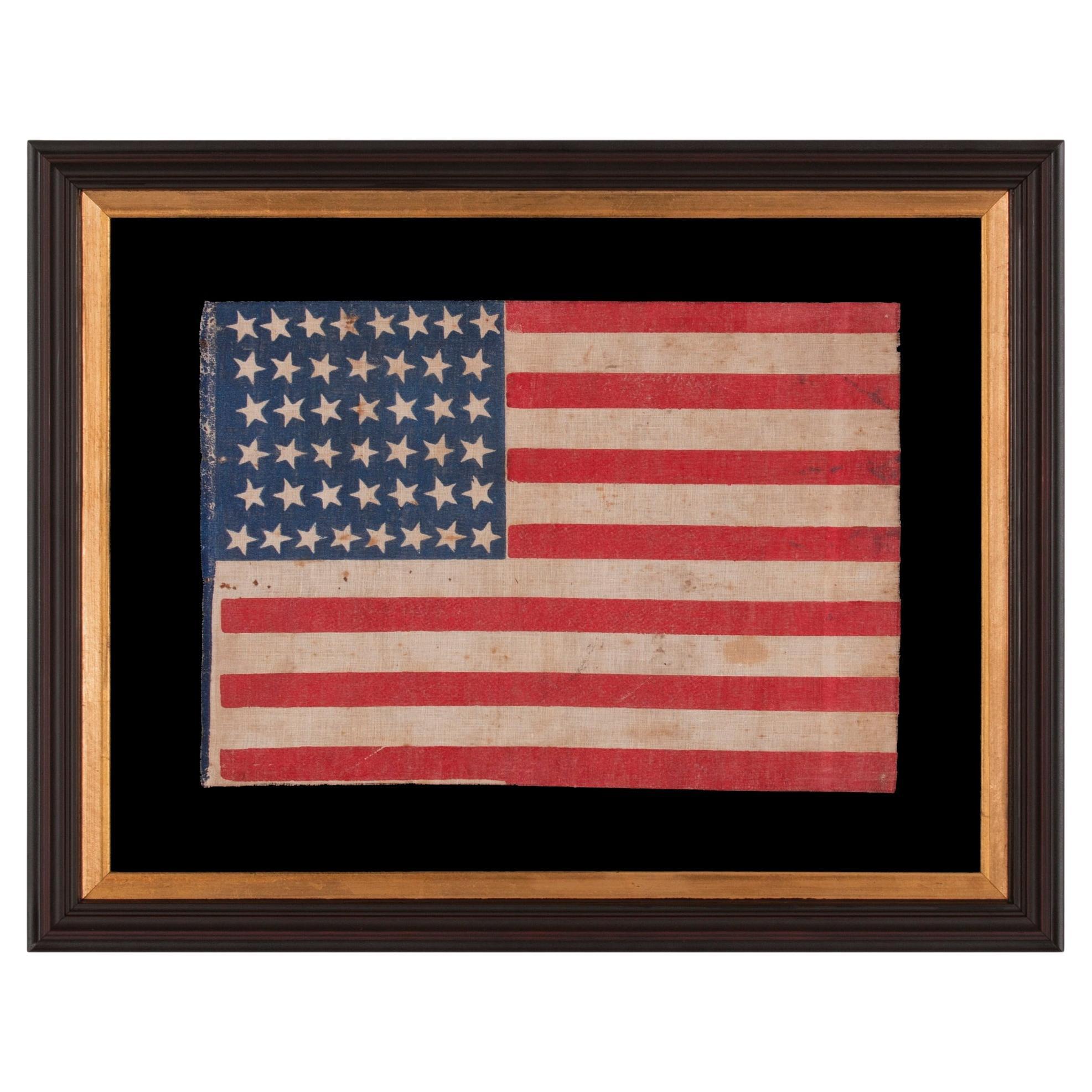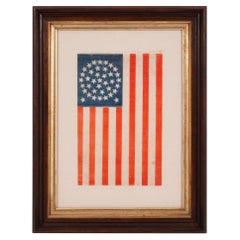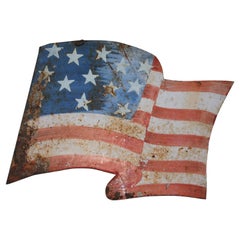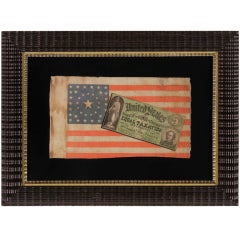
Extremely Rare Parade Flag With Rare Circle-in-a-square Star Configuration
View Similar Items
Want more images or videos?
Request additional images or videos from the seller
1 of 6
Extremely Rare Parade Flag With Rare Circle-in-a-square Star Configuration
About the Item
- Dimensions:Height: 16.75 in (42.55 cm)Width: 22.25 in (56.52 cm)
- Period:
- Date of Manufacture:1868
- Condition:See Item Description.
- Seller Location:York County, PA
- Reference Number:Seller: 40j-8081stDibs: LU8497818136
About the Seller
5.0
Recognized Seller
These prestigious sellers are industry leaders and represent the highest echelon for item quality and design.
Established in 1991
1stDibs seller since 2008
61 sales on 1stDibs
Typical response time: 10 hours
More From This SellerView All
- 38 Star Parade Flag with Stars in a Medallion Configuration, ca 1876-1889Located in York County, PA38 STARS IN A MEDALLION CONFIGURATION WITH 2 OUTLIERS, ON AN ANTIQUE AMERICAN FLAG WITH VIBRANT COLORATION, REFLECTS COLORADO STATEHOOD, 1876-1889, ILLUSTRATED IN “THE STARS & STRIPES: FABRIC OF THE AMERICAN SPIRIT” by RICHARD PIERCE, 2005 38 star American parade flag, printed on coarse, glazed cotton. The stars are arranged in a triple-wreath form of the medallion configuration, with a single center star and two stars flanking outside the basic pattern, toward the fly end. Most circular medallion patterns of this sort exhibit four flanking stars beyond the consecutive wreaths, one in each corner. The inclusion of only two was intentional, allowing for the easy addition of two more stars. Flag-makers knew that more Western Territories were soon to be added and eagerly anticipated their arrival. Use of fewer than four outliers was popular in 38 star parade flags, but is rarely encountered in other star counts. Note how the vibrant, chromatic luster of the orange stripes provides striking contrast with the blue canton, and how this contributes to the flag's beautiful presentation. Many parade flags in this star count have red stripes that lean heavily toward orange. This was common across printed flags produced between the 1850's and the 38 star period, phasing out in the last decade of the 19th century. Colorado became the 38th state on August 1st, 1876. This was the year of our nation’s 100-year anniversary of independence. Per the Third Flag Act of 1818, stars were not officially added until the 4th of July following a state's addition. For this reason, 37 was the official star count for the American flag in 1876. Flag-making was a competitive venture, however, and few flag-makers would have been continuing to produce 37 star flags when their competitors were making 38’s. It is for this reason that 38 and 13 stars (to represent the original 13 colonies) are more often seen at the Centennial International Exposition, the six-month long World’s Fair held in Philadelphia in honor of the event. Some flag-makers would have been adding a star for the 38th state even before it entered the Union, in the early part of 1876 or even prior. In fact, many makers of parade flags were actually producing 39 star flags, in hopeful anticipation of the addition of two more Western Territories instead of one. But the 39th state would not join the Union for another 13 years, when the Dakota Territory entered as two states on the same day. The 38 star flag generally fell from use at that time, though it technically remained official until July 3rd, 1890. President Ulysses S. Grant was in office when the first 38 star flags would have appeared. The list of presidents serving during the period when the 38 star flag was actually official, include Rutherford B. Hayes, James Garfield...Category
Antique Late 19th Century American Political and Patriotic Memorabilia
MaterialsCotton
Price Upon Request - 13 Star American Parade Flag with Rare Design, Ca 1888 Ex Richard PierceLocated in York County, PA13 Star American parade flag in an extremely rare design, with “protection to home industries” slogan on a fanciful, scrolling streamer, made for the 1888 presidential campaign of Benjamin Harrison; formerly in the collection of Richard pierce. 1888 Benjamin Harrison campaign flag, printed on cotton, with 13 large stars in a 3-2-3-2-3 pattern, upon which a whimsical, scrolling streamer is superimposed that features the slogan: “Protection to Home Industries.” There are numerous styles of both documented and undocumented, red, white, and blue bandanas and handkerchiefs, made for Harrison’s campaign in this year, as well as from the subsequent one, in 1892. Most bear variations of text to support the “Protection for American Industries” platform of the Republican Party. America was in the midst of the industrial age and there was a great deal of public interest, both in protecting growth and discouraging both imported goods and immigration. The constant stream of immigrants posed great challenges for a working families, competing for scarce jobs, in work environments that were already often far from ideal. In post-Civil War America, many of the working men were Civil War veterans. Bandanas abound from Harrison’s Campaigns, but flags do not. This example, along with three others, were once part of an 1888 patriotic quilt that was disassembled by a dealer and sold piecemeal to collectors. I eventually acquired all four. Fifteen to twenty years ago, these were the only four known copies. A couple of others have since surfaced, but the total count known still stands closer to 5 than 10. The use of 13 stars is seen in the flags of various candidates in the 19th century. Among these are Abraham Lincoln (1860 campaign), Henry Clay (1844 campaign), John Fremont (1856), and Benjamin Harrison’s grandfather, William Henry Harrison...Category
Antique 1880s American Political and Patriotic Memorabilia
MaterialsCotton
Price Upon Request - 38 Star Parade Flag with Whimsical 6-Pointed Stars, Colorado StatehoodLocated in York County, PA38 WHIMSICAL STARS, WITH 6-POINTED PROFILES, SIMILAR TO THE STAR OF DAVID, ON AN ANTIQUE AMERICAN FLAG OF THE CENTENNIAL ERA; A REMARKABLE SPECIMEN, ONE-OF-A-KIND AMONG KNOWN EXAMPLE...Category
Antique Late 19th Century American Political and Patriotic Memorabilia
MaterialsCotton
Price Upon Request - 42 Star Antique American Parade Flag, Ca 1889-1890Located in York County, PA42 STARS ON AN ANTIQUE AMERICAN FLAG WITH SCATTERED STAR POSITIONING, REFLECTS THE ADDITION OF WASHINGTON STATE, MONTANA, AND THE DAKOTAS, NEVER AN OFFICIAL STAR COUNT, circa 1889-18...Category
Antique Late 19th Century American Political and Patriotic Memorabilia
MaterialsCotton
Price Upon Request - 36 Star Antique American Parade Flag, with Canted Stars, ca 1864-1867Located in York County, PA36 STAR ANTIQUE AMERICAN PARADE FLAG WITH CANTED STARS IN DANCING ROWS, ON A BEAUTIFUL, CORNFLOWER BLUE CANTON; CIVIL WAR ERA, NEVADA STATEHOOD, 1864-1867 36 star antique American f...Category
Antique 1860s American Political and Patriotic Memorabilia
MaterialsCotton
Price Upon Request - 34 Star Antique American Parade Flag, Kansas Statehood, ca 1861-1863Located in York County, PA34 STARS IN A MEDALLION CONFIGURATION ON AN ANTIQUE AMERICAN PARADE FLAG WITH A LARGE, HALOED CENTER STAR; CIVIL WAR PERIOD, KANSAS STATEHOOD, 1861-1863 34 star American national pa...Category
Antique 1860s American Political and Patriotic Memorabilia
MaterialsCotton
Price Upon Request
You May Also Like
- 46-Star American Flag Printed in Drum Star ConfigurationLocated in Colorado Springs, COThis is an original 46-Star American parade flag, celebrating Oklahoma statehood. Each star on the flag's canton represents a state in the Union at the time. The official flag design would update every July 4th, to include any new states added to the Union in the past year. Oklahoma, the 46th state, entered the Union on November 16, 1907. As such, this 46–star flag was the official flag of the United States from July 4, 1908, until July 4, 1912. The silk flag has a dark blue canton with 46 white printed stars. The stars are printed in an 7-8-8-8-8-7 row configuration, or “Drum design.” The flag design is completed with 13 alternating red and white stripes, each stripe representing one of the original thirteen colonies. The land that comprises Oklahoma today was added to the United States as part of the Louisiana Purchase of 1803. Throughout the 19th century, the U.S. government relocated Indian tribes from the southeastern United States to the area, and by 1900, over 30 Indian tribes had been moved to what was originally called the Indian Territories. At the same time, ranchers in Texas began to move into the area in search of new pasture lands. Although stipulations in the Indian Relocation Act agreed that the land would forever be Indian Territory, the promise of fertile farmland trumped the government’s promise of sovereignty. On April 22, 1889, they opened the land to settlement by homesteaders, creating a land run in which settlers, called “Boomers,” were allowed to cross the Texas or Arkansas border at a particular hour to claim homesteads. Settlers who illegally crossed the border earlier to stake prime land were called “sooners,” which eventually became the state’s nickname. Wagons and the Santa Fe railroad carried cartloads of men and women to blank town sites and building plots, creating ten thousand-people communities in a matter of days. The following year, the region was further divided into Indian Territory and Oklahoma Territory...Category
Vintage 1910s American Political and Patriotic Memorabilia
MaterialsSilk
- Original Painted Metal Parade FlagLocated in Los Angeles, CAThis fun and folky 20thc original painted parade flag sign was used to hand in the windows during patriotic events. In stores and homes in the early 20thc.Category
Antique Late 19th Century American Adirondack Political and Patriotic Me...
MaterialsTin
$1,036 Sale Price20% Off - 36-Star Printed American Flag, Rare Haloed Star Medallion, Circa 1865Located in Colorado Springs, COThis 36-star flag has stars arranged in a gorgeous and highly desirable medallion pattern. This particular medallion includes a large haloed star in the middle, two rings of stars s...Category
Antique 1860s American Political and Patriotic Memorabilia
MaterialsFabric
- 39-Star Antique American Flag with 'Whimsical' Star Pattern, 1889Located in Colorado Springs, COThis is a 39-star unofficial American flag, handmade and printed on cotton. The flag dates to 1889 and has a unique history, thanks to its rare star-count. The flag’s canton is prin...Category
Antique 1880s American Political and Patriotic Memorabilia
MaterialsCotton
- Rare Monumental 1890 Antique 42 Star United States of America FlagLocated in Dayton, OHMonumental fifteen foot 42 star American flag, circa 1889-1890. The 42-star flag is rare because only a limited number of 42-star flags were produced after Washington became a state on Nov. 11, 1889. But it takes a more intimate knowledge of flag trivia to know just why it happened this way. White stars are added to the blue field of the star-spangled banner on the Fourth of July after a state is admitted to the union. In the fall of 1889, several western territories became states. Dakota was admitted, and then split into North and South Dakota, on Nov. 2, 1889, which made them state and star numbers 39 and 40. Montana was named the 41st state on Nov. 8, followed by Washington, on Nov. 11. Only a few flag manufacturers began producing 42-star flags before the official addition of the 42nd star on July 4, 1890. Those who tried to jump the gun by being the first to produce an up-to-date flag were surprised when Idaho was admitted to the United States on July 3...Category
Antique 1890s American Classical Historical Memorabilia
MaterialsCotton
- Large 48 Star Embroidered Flag PillowBy American Flag & Banner Co.Located in Los Angeles, CAThis monumental 48 star flag pillow is in great in great condition and has a red cotton linen pillow. The big pillow id down and feather fill.Category
Mid-20th Century American Country Political and Patriotic Memorabilia
MaterialsCotton
$375 Sale Price36% Off
Recently Viewed
View AllMore Ways To Browse
Political Campaign Memorabilia
Square Small Picture Frame
Lost Memorabilia
19th Century Collins
Antique Ohio State
Preston And York
Mask Lady
Mens Gold Frame Glasses
Grover Cleveland
For A Few Dollars
War Bonds
Non Heat Treated
Antique Preston
Antique Change Holder
Antique Bonds
Blairs Used Furniture
40s Platforms
Abraham Lincoln Memorabilia
